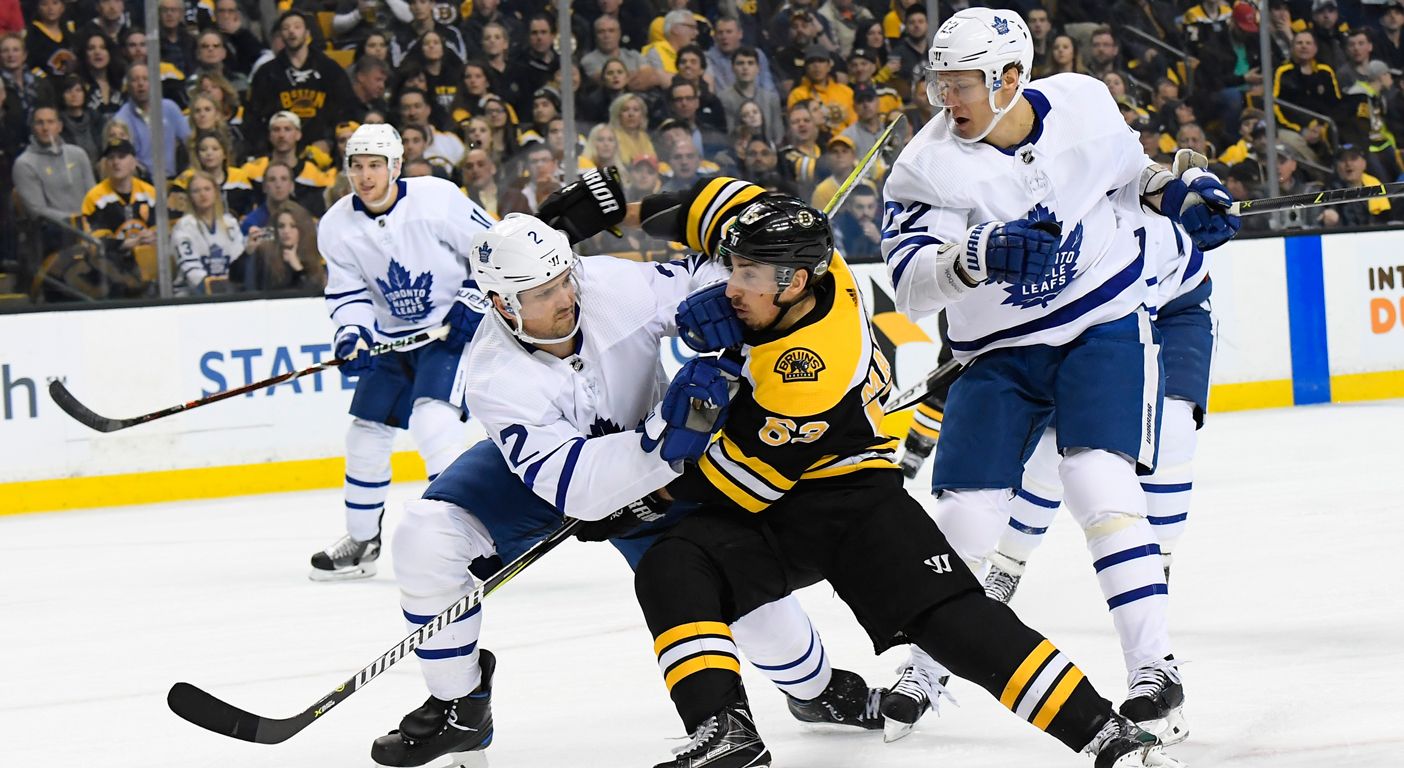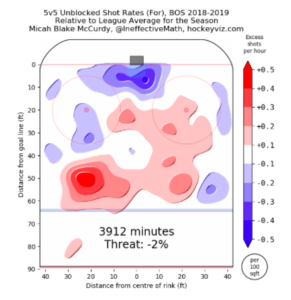Thanks to the NHL’s divisional playoff format, the Toronto Maple Leafs’ first-round matchup has been blatantly obvious for months now. A rematch with the Boston Bruins will start next Thursday night, and for many Leafs fans, there’s no team they would rather beat.
Let’s get one thing out of the way early: This may be round three for you, the fan, but it is not round three for the players. Nazem Kadri and Jake Gardiner are the only holdovers from Toronto’s 2013 playoff roster. Mitch Marner hadn’t even made his OHL debut yet. The Bruins roster featured Tyler Seguin, Milan Lucic, Nathan Horton, Dougie Hamilton, Johnny Boychuk, and Jaromir Jagr, among others. These are completely different rosters.
Last year’s series featured Tomas Plekanec matching up against Patrice Bergeron for a significant part of the series (frankly, I was surprised the Leafs pushed it to seven games following a slow start and Nazem Kadri’s suspension). John Tavares and Jake Muzzin represent two huge additions to this year’s roster, so once again, we have a fairly different matchup on our hands in 2019.
Here’s the most recent lineup that I found for the Bruins before they started resting players:
| LW | C | RW | LD | RD |
|---|---|---|---|---|
| Marchand | Bergeron | Pastrnak | Chara | McAvoy |
| DeBrusk | Krejci | Johansson | Krug | Carlo |
| Heinen | Coyle | Wagner | Grzelcyk | Clifton |
| Nordstrom | Acciari | Backes |
Their first line is incredible. Their second line is quite strong in terms of controlling play. The Leafs should be able to out-score Boston’s third and fourth lines, but they sure know how to play boring hockey. The Bruins have experimented with flipping Pastrnak and Johansson; that’s scary to me, as it provides them with a more balanced attack. For now, I will assume that they will stay with the dominant Marchand-Bergeron-Pastrnak line, but that could change if the Leafs jump ahead in the series.
Bruins by the Numbers
Statistics retrieved from Corsica and NHL.com.
Five-on-Five
| Bruins: 5v5 | ||
|---|---|---|
| Goals For per 60 | 2.33 | 20th |
| Goals Against per 60 | 1.91 | 1st |
| Goal Differential % | 54.91% | 4th |
| Expected Goals For per 60 | 2.27 | 23rd |
| Expected Goals Against per 60 | 2.1 | 3rd |
| Expected Goal Differential % | 51.91% | 10th |
Special Teams
| Bruins: Special Teams | ||
|---|---|---|
| PP | 26.3% | 3rd |
| PK | 80.1% | 17th |
The Bruins are a pretty boring team, at least until they are on the power play. They defend exceptionally well at five-on-five: They rank first in terms of goals against per minute and third in terms of expected goals against per minute. They play a conservative style and always seem to have one forward back to support their defensemen while defending in transition.
The Bergeron line brings plenty of offense and David Krejci has posted fairly strong numbers this year on the second line with Jake DeBrusk, but this Bruins roster doesn’t exactly burn out the goal light at five-on-five. Even after the additions of Charlie Coyle and Marcus Johansson, Boston’s roster does not come close to matching Toronto’s scoring depth.
While the Leafs obviously have to hold their own in the one-on-one puck battles to win come playoff time, the key to beating the Bruins is not to outmuscle them. With players like Chara, Carlo, DeBrusk, Wagner, and Miller on the roster, you would have to completely change Toronto’s roster makeup in order to out-match them physically. You will want to stretch them out to create odd-man rushes and avoid chasing in the defensive zone.
The key to beating the Bruins is staying out of the penalty box, defending competently against the Bergeron line, and finding a way to generate chances against their outstanding five-on-five defense. It’s difficult to outplay Boston’s first line, so the Leafs will have to look to capitalize on their scoring depth advantage. Obviously, puck luck and strong goaltending are also keys to a playoff series win, as they always are.
Systems Analysis
Don’t Let Patrice Bergeron Get Loose in the Slot
When you’re busy worrying about Marchand and Pastrnak as they pass it back and forth, you often lose coverage of Bergeron in the process. He leads the Bruins in shots per minute at five-on-five this year and he’s a top ten player in the league in this statistic over the past three seasons. He will fire plenty of one-timers from the slot and he’s perfectly capable of beating goalies from a distance.
Bergeron is an incredibly smart player. While his opponents are desperately rushing back to stop the rush in the clip above, he curls behind them to create enough space to unload his one-timer. If it doesn’t go in, he’s high in the offensive zone and in a good position to defend a rush the other way.
Bergeron starts the above clip by covering for his pinching defenseman. Marner takes Marchand, and since Bergeron is so far from the net, Hyman decides to help out his linemate. As soon as Hyman commits to Marchand, Bergeron jumps up into the slot and fires a one-timer. You’ll notice how Pastrnak is on the left side at the end of this clip, which will be discussed later in this article.
The Leafs are scrambling back to defend Marchand and Pastrnak here, and once again, Hyman doesn’t notice that Bergeron is sneaking up behind him. In addition, note that Marchand is on the right side here, with Pastrnak on the left.
Bergeron does not have much space at the start of the clip above. Rather than moving closer to the net, he backs up to create space for his shot. He doesn’t score here, but he’s perfectly capable of scoring from a distance and the Bruins recover more than their fair share of rebounds. Since Bergeron is high in the offensive zone, Chara can be aggressive and pinch. Once again, Marchand sets up the play from the right side, with Pastrnak ready for a one-timer on the left.
Bergeron starts the above clip down-low in the defensive zone. Tampa scrambles to get back and two players decide to cover Marchand. There’s no communication between Brayden Point and Ryan McDonagh here, as they both take Marchand at first before abandoning him once they realize Bergeron is all alone. If you overcommit against Boston’s top line, they usually make you pay by finding the open player trailing behind.
If you still don’t believe me, I will leave you with the above video to watch all of Bergeron’s goals from the 2017-18 season. Count the number of times that Bergeron sneaks his way into the slot and ends up wide open. Observe the number of times where the other team over-commits to his wingers and pays no attention to him trailing behind. At the 50-second mark, you’ll find a good example of this against the Leafs.
The Marchand-Pastrnak Winger Switch
Both Marchand and Pastrnak are above average skaters, allowing them to cover a ton of space on the forecheck. Hainsey has the puck on the left side of the ice here, where the Bruins have four defenders to help take away space. Marchand then curls to the right side to create a shorter and more effective transition pass. The two wingers basically skate in “figure 8s” out there.
Pastrnak starts on the right side here and then ends up skating behind Marchand at the opposite end of the ice. The defender thinks this pass is going to Marchand here, but it instead goes to a streaking Pastrnak to set up a clean zone entry.
The Bruins love to make these short chip-pass through the neutral zone. Since Marchand and Pastrnak can zoom across the ice, they usually are quite successful in gaining the zone. While Marchand jumps over the right side, Pastrnak crosses over to the left. Predictably, Marchand spins around and finds a wide-open Bergeron, who snuck into the slot relatively uncovered.
Pastrnak starts at his own blueline in the clip above and he’s right in the middle of the ice. He stays on the left side this entire sequence and waits for a one-timer like he’s on the power play. Marchand is also a one-timer threat from the right side, so this works in their favour. When the Bruins are in the offensive zone, you want to treat Pastrnak like a left-winger and Marchand like a right-winger.
Team Defence
I won’t analyze this clip-by-clip, as they aren’t exactly amazing highlights, but I regularly noticed how low all five Bruins players get in the defensive zone. When they finally get the puck back, they are usually in a position to receive a short outlet rather than a long stretch pass. They can be a bit of a chip-and-chase team at times, but they are quite fast and strong on the forecheck, so the short but high-percentage outlet pass works quite well for them. Since they are so low in the defensive zone, they seem to leave the points open a little bit more than most teams.
Other Notes
As mentioned earlier, the Bruins allow the fewest goals per minute at five-on-five. This is going to be an interesting matchup, as the Leafs have plenty of firepower to counter this:
Single season 5v5 primary points per minute leaders over the past five seasons (min 800 minutes):
1. Auston Matthews 2.6 (2017-2018)
2. Mitch Marner 2.6 (2018-2019)
3. Rick Nash 2.57 (2014-2015)
4. Evgeni Malkin 2.55 (2016-2017)
5. John Tavares 2.51 (2018-2019)— Kevin Papetti (@KPapetti) March 30, 2019
5v5 primary points per 60 leaders this season (800+ min):
1. Mitch Marner 2.6
2. John Tavares 2.51
3. Sidney Crosby 2.43
4. Nikita Kucherov 2.4
5. Auston Matthews 2.36
6. Brayden Point 2.35
7. Connor McDavid 2.34
8. Max Domi 2.28
9. Elias Pettersson 2.24
10. Artemi Panarin 2.2— Kevin Papetti (@KPapetti) March 29, 2019
If there’s any team that can figure out a way to score against the Bruins at five-on-five, it’s the Leafs. The Tavares-Marner duo will try their best to come close to breaking even against the Bergeron line, so it will be up to the other lines to create an edge in Toronto’s favour. Matthews and Nylander are certainly capable of out-scoring Krejci and DeBrusk, Kadri and Kapanen are certainly capable of out-playing Coyle’s unit, and Ennis can help to create more offense than Boston’s fourth line.
The Bruins are an exceptional defensive team with a dominant first line, an exceptional power play, and strong goaltending. You’re going to want to stay out of the penalty box. Among players with 500+ minutes on the power play over the past three seasons, Pastrnak ranks second in goals per minute behind only Steven Stamkos. I would treat Pastrnak like he’s Ovechkin, while both Marchand and Bergeron are dangerous shooting threats as well. Do your best to stop them from getting set up in the first place, but ultimately, they will eventually make you pay if you continue to give them chances.
At five-on-five, make sure you’re between Marchand and your goalie, but avoid having multiple defenders overcommit to him. He’s a beast in the cycle from a puck protection perspective and he’s waiting for you to overcommit so that a passing lane opens up. It’s similar to what we always see in the NBA, where LeBron drives to the rim, brings everyone with him, then dishes it out to a wide-open player.
Fortunately, Marchand isn’t quite LeBron, so you can trust your teammate to contain him a little bit more and focus on covering your own defensive assignment. Make sure you cover Bergeron, as he trails behind the play and tries to sneak into the slot. Their wingers love to burst into the offensive zone, curl up suddenly, and make a drop-pass to their center. You can see how Boston generates plenty of opportunities from the “Bergeron spot” here.
(Note: I strongly recommend checking out hockeyviz.com):
Series Outlook and Final Thoughts
The Leafs are better than they were last year, while the Bruins are quite similar. Kadri’s suspension left Toronto with no matchup center to face the Bergeron line as none of Matthews, Bozak, Plekanec, Moore should have been in that spot. John Tavares is a huge difference maker, while Jake Muzzin will upgrade on Roman Polak’s spot in the lineup.
Another positive for Leafs fans is that the Bruins will lose their backup goalie advantage. Andersen can’t play all 82 games, but he’s certainly expected to play every playoff game. If Garret Sparks had the same save percentage as Boston’s backup goalie, Jaroslav Halak, Toronto’s goal differential would have improved by 10 goals over those 20 games. While Boston could play either goalie if one struggles, their backup goalie advantage is less significant in a playoff series.
The Leafs have a clear edge in terms of scoring talent and this series is far more even than most Leafs fans believe. These two teams are essentially tied in terms of expected goal percentage at five-on-five. The Leafs also have the scoring talent to outperform their expected goal numbers.
As always, goaltending and puck luck are the biggest keys to a series win. Anyone can beat anyone in the NHL playoffs. Another major factor will be whether or not the Leafs can get their power play rolling. We’ve seen this team score in bunches with the man-advantage, and we’ve also seen them look like a bottom-ten team in this regard. The Bruins are a strong defensive team that lacks scoring depth at five-on-five, so the Leafs will want to stretch out Boston’s defense and aggressively attack when Bergeron is off the ice. Fortunately, if there’s any team that can breakthrough Boston’s five-on-five defense, it’s the Toronto Maple Leafs.
We should be in for a great series.
Banner image courtesy of NHLI via Getty Images














![John Gruden after the Leafs prospects’ 4-1 win over Montreal: “[Vyacheslav Peksa] looked really comfortable in the net… We wouldn’t have won without him” John Gruden, head coach of the Toronto Marlies](https://mapleleafshotstove.com/wp-content/uploads/2025/09/gruden-post-game-sep-14-218x150.jpg)



















